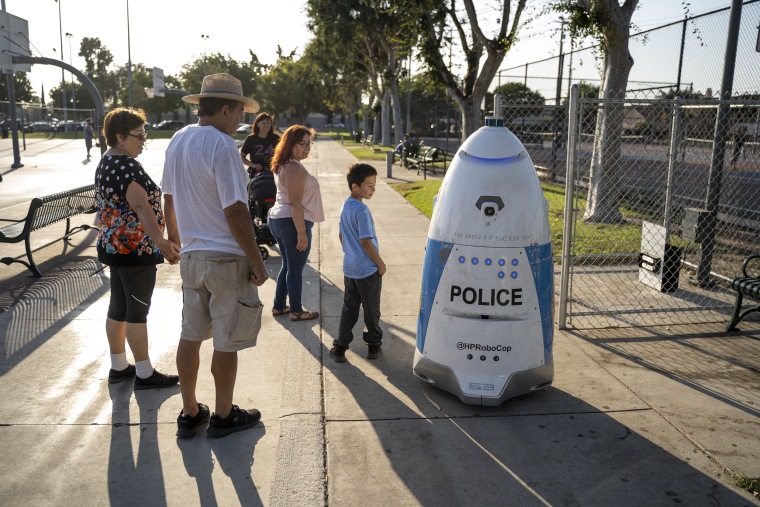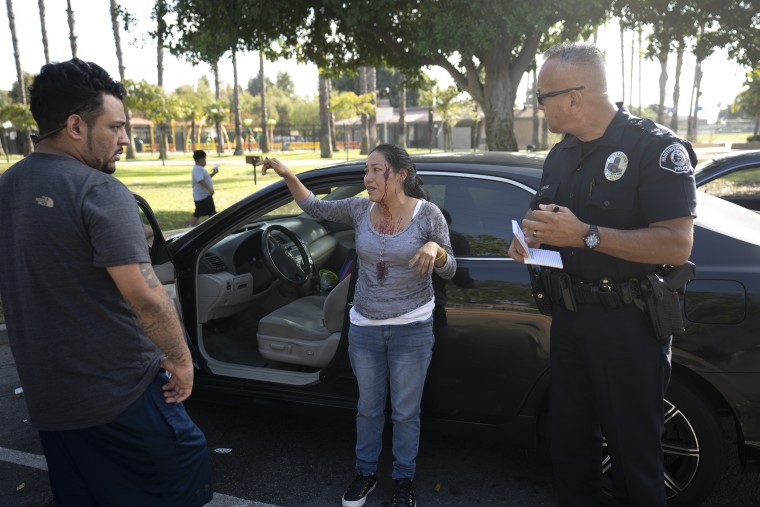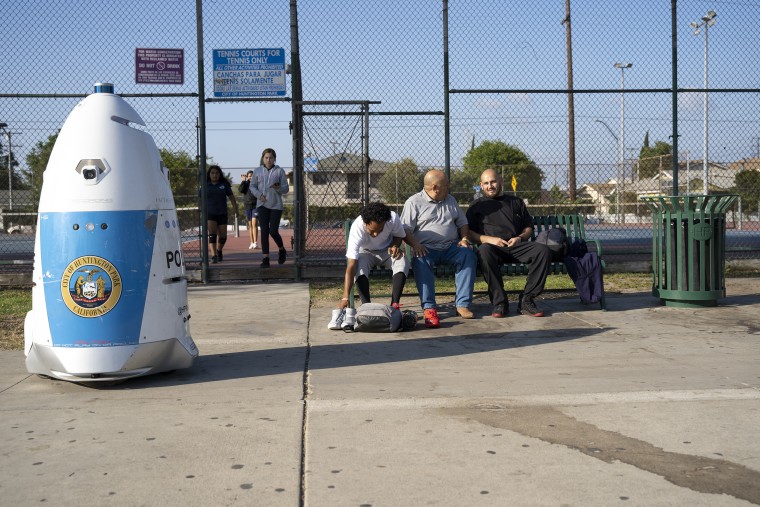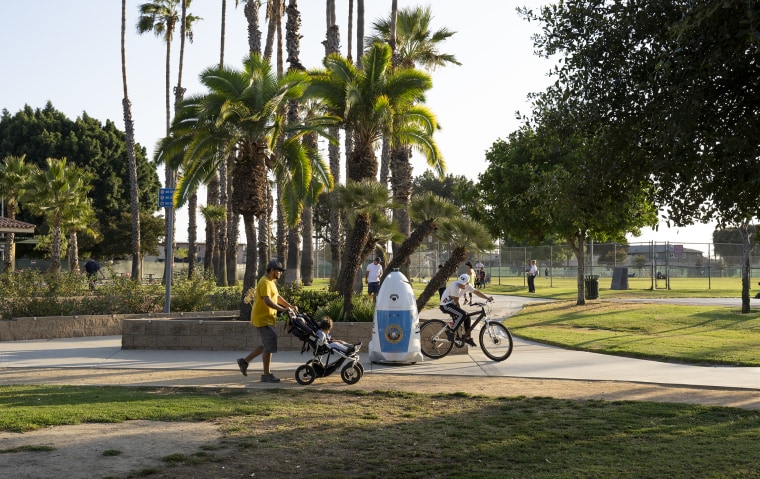HUNTINGTON PARK, Calif. — When a fight broke out recently in the parking lot of Salt Lake Park, a few miles south of downtown Los Angeles, Cogo Guebara did what seemed the most practical thing at the time: she ran over to the park’s police robot to push its emergency alert button.
“I was pushing the button but it said, ‘step out of the way,’” Guebara said. “It just kept ringing and ringing, and I kept pushing and pushing.”
She thought maybe the robot, which stands about 5 feet tall and has “POLICE” emblazoned on its egg-shaped body, wanted a visual of her face, so she crouched down for the camera. It still didn’t work.
Without a response, Rudy Espericuta, who was with Guebara and her children at the time, dialed 911. About 15 minutes later, after the fight had ended, a woman was rolled out on a stretcher and into an ambulance, her head bleeding from a cut suffered during the altercation.
Amid the scene, the robot continued to glide along its pre-programmed route, humming an intergalactic tune that could have been ripped from any low-budget sci-fi film. The almost 400-pound robot followed the park’s winding concrete from the basketball courts to the children’s splash zone, pausing every so often to tell visitors to “please keep the park clean.”

The robot, officially named HP RoboCop, has been patrolling Salt Lake Park for the Huntington Park Police Department since June. NBC News visited the park numerous times to observe its operation and its interactions with people.
While people are beginning to more commonly encounter robots in everyday life, they can often fall short of expectations — much as HP RoboCop did. That gap can be exploited as a way to make a robot more effective than it actually is, but also runs the risk of creating situations in which people rely on robots in ways they’re unprepared for, as was the case for Guebara.
The robot’s alert button is not yet connected to the police department, said Cosme Lozano, chief of police of Huntington Park, a city just southeast of downtown Los Angeles. The calls are instead directed to Knightscope, the company that creates and leases the robots.
“That’s why we’re not advertising those features,” he said. “It’s a new program for us and were still developing some protocols… to be able to fully adopt the program.”
On patrol
HP RoboCop is one of more than 70 autonomous security robots developed by Knightscope. The Silicon Valley company says it has combined self-driving technology, robotics and artificial intelligence to create what it calls “crime-fighting autonomous data machines.” The robots are deployed across the U.S., serving everywhere from airports to gas stations.
Lozano said the department is facing some technical challenges incorporating the robot into the force, adding that it’s on “a trial basis for the city.” Once fully connected, the calls will go directly to the department’s dispatch center, he said.

HP RoboCop is a K5 model, specialized for outdoor use, and is one of the company’s first to wear a police moniker. Knightscope’s website promotes some of the K5’s abilities as including a 360-degree high-definition live video stream, a license plate reader that can scan 1,200 plates a minute, a two-way intercom and the ability to track cell phone use in the vicinity.
But as it is currently used, HP RoboCop is little more than a glorified security camera on wheels. The robot’s five cameras provide 24/7 live monitoring, with the ability to send footage directly to officers’ phones, but that’s currently only accessible to Knightscope. It’s another feature that the police are working on activating, Lozano said.
The robot is confined to the park’s cement path, which has been blocked by construction for a new aquatics center, curtailing its patrol of the north end of the park. Leasing the robot for a year costs the city between $60,000-$70,000, Lozano said. As of 2018, a Huntington Park police officer with a basic assignment makes an annual salary that falls in the same range.
Other Knightscope robots have not been without tribulations. One K5 robot patrolling around an office complex in Washington, D.C., ended up falling into a fountain. Another of the same model struck a toddler at a shopping mall in Silicon Valley.
Great expectations
The city’s official adopted name for the machine is HP RoboCop, but everyone in the park seems to have their own nicknames for it. “R2D2,” “Spy Machine,” and “Wall-E’’ are just some of the pet names that highlight the disconnect between people’s expectations of the robot and the reality of its capabilities.

Concession stand worker Orlando Enrique said he’s noticed a change in people’s behavior since the robot’s arrival. Just its presence seems to offer a sense of reassurance to many.
“A lot of people like it because they feel secure,” he said. “They can leave their kids.”
Enrique, 28, lives in Norwalk, California, and has worked at the snack bar for nine years. The store closes at 10:30 p.m. and now with the robot there, he feels more comfortable walking to his car after a shift.
People come from all over to see it, Enrique said, referring to the mini-tourist boom that HP RoboCop brought to the park. It is especially popular among kids.
On Labor Day, curious children trailed HP RoboCop as it patrolled. One little boy bumbled behind with a bag of Doritos in tow. He stared at the machine, doe-eyed, before lightly stroking its cylinder body ― until another boy asked, “Why are you petting it like a dog?”
This anthropomorphizing of the robot is totally normal, said Ross Knepper, an associate professor in the department of computer science at Cornell University.
There are a lot of unknowns when it comes to these machines, and humans just don’t have the right expectations to draw from, so they refer to “Hollywood magic,” he said. People recall what they’ve seen in movies and transfer those expectations onto the real thing.
“It’s something the brain automatically tries to do,” said Knepper, who is helping develop robots that can work with humans as peers rather than tools.
This can lead people to believe that a robot is much more capable and intelligent than it really is and can create a false sense of security, he said.
Violeta Alvaraz, who was visiting the park with her kids and mother, is from the neighboring township Bell, and learned about HP RoboCop through her son. His generation is more comfortable with that kind of technology, she said, commenting that to her it looked like a 1970s washing machine.
Though she said she appreciates the city’s investment in their safety, Alvaraz still has plenty of questions.
“Are we going to get in trouble if we touch it?” she asked. “Who’s guiding it? I don’t know how it works. Should I still call 911?”
‘Tipping’ point
Most people in the park who spoke with NBC News were fond of HP RoboCop, usually attaching a “he” pronoun when speaking about it, but all admitted they did not know its full functionality.
Despite HP RoboCop’s months-long tenure in the park, there is no signage describing what it does or why it is there. Lozano said that’s because the department does not want to falsely advertise the robot, but the information will be posted when the machine’s features are properly connected, he added.
Leveraging people’s uncertainty about the robot is core to its value as a security tool, Knepper said.
The fact that the public is unaware of all of the robot’s capabilities is integral to Knightscope robots’ mission to be a physical deterrent to crime, confirmed Stacey Stephens, the company’s executive vice president and chief client officer.

“They could have any kind of grand thought about what the robot might be able to do, which could lead them to say, ‘you know what, I’d rather not risk it. Let me go somewhere else,’” Stephens said.
Crime in the robot’s patrol zone has gone down, Lozano said. Though that’s hard to measure, the police have not had to contact Knightscope to review footage, except for the few times the robot itself was vandalized, he said. HP RoboCop has weathered a few minor personal assaults, including fielding a “wheelie” from a biker who purposefully rode into it. But the only significant damage was when the police first deployed the robot, Lozano said. Officers were able to track down the suspects of what he called the “robot tipping incident,” using HP RoboCop’s own footage.
Still, the police took the assault personally, said Lozano. The children in the park aren’t the only people who have developed something of an affinity for HP RoboCop. “How could you go mess with our robot?” Lozano said. “You would think the robot was murdered. We kind of jumped on it like we would have a significant crime.”
Talk the talk
Even if they are simple phrases, a robot’s ability to talk can change how people feel about it, Knepper said. As soon as it speaks, people’s expectations are dramatically altered.
“As researchers, we are very eager to employ all these new technologies, speech and acting in a socially competent way, but if we don’t have this other side of setting expectations of awareness of how people will interpret these behaviors, we run the risk of actually making an interaction with the robot worse and not better,” Knepper said.
Stephens prefers not to use the name HP RoboCop. He said it gives a false impression of the Knightscope’s mission, which is to gather intelligence for law enforcement.

“I think what people have in their head when they hear RoboCop is something that is going to shoot everybody up and intervene in a crime and that’s not what this is about,” he said.
Stephens was referencing the titular RoboCop from a series of movies that began in the late 1980s, offering a futuristic vision of a human-machine crime fighter and an explanation for why expectations about robotics in policing can quickly surpass reality. The character remains a relevant pop culture figure, with a new RoboCop movie released in 2014 and another currently in development.
But HP RoboCop seems to elicit the opposite reaction ― consistently followed by an entourage of kids high-fiving or holding its can-shaped body like a fifth-grade dance partner. Although a company can’t control how people project their imagination onto robots, said Knepper, it can encourage them to recall certain references through design.
Despite all of HP RoboCop’s capabilities, both real and perceived, it does not have the capacity to explain itself. The city, however, has an obligation to educate the public about the technology it’s using, Knepper said. This could also help the police achieve their goals of reducing crime.
“Once people really understand what’s at stake, I think they will modify their behavior in much more predictable ways,” he said.
CORRECTION (Oct. 11, 2019, 8:15 a.m. ET): A previous version of this article misspelled the first name of a visitor to the park. She is Violeta Alvaraz, not Violete.
